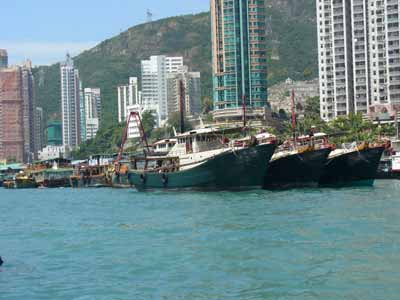TABLE
OF CONTENTS
|
Hong Kong
ByKristin Trapp

Hong Kong’s
urbanism was a lot easier to see than I had imagined it would be. As I was walking through the many streets of Hong Kong I began to look for distinct markings
and
buildings that really shouted transnational or vernacular urbanism. To my surprise they were everywhere. I then decided to look a little closer at
some of the dimensions of global cultural flow including ethnoscapes,
mediascapes, and finanscapes most of them were as easily visible as
well.
Ethnoscapes
are the ways tourists, immigrants, refugees and guest workers move
about a city,
as explained by Short and Kim in their book Globalization and the
City. This was a not a challenging
observation
since a good portion of Hong Kong’s population consists of many people
from the
Middle East, Philippines and Britain. As
a tourist I felt it was much easier to travel in Hong Kong as opposed
to Japan,
because
the majority of the people spoke English and the street signs were
written in English. In this context
refugees and guest workers
were also not that difficult to spot. Sundays
in the town centers are saturated with Filipino women all socializing on their only day off from their jobs as
domestic workers. My visit included a Sunday visit, so I was able to
see the
women chatting, exchanging foods and doing each other’s hair... Still wanting to learn more about the city I
looked
to another dimension, for instance mediascapes.
Mediascapes
are the worldwide distribution of information through newspapers,
magazines, TV
program and films. This was not as hard
to observe since there were TVs, newspapers and magazines everywhere,
the only
problem was I don’t speak or read Mandarin or Cantonese, so to the best
of my
knowledge the mediascapes for Hong Kong do have a world wide
distribution of
information. This brought me to my last
dimension, finanscapes. Finanscapes are
the global capital flow. Hong Kong really shocked me when it came to
their
cities. I never did make it to Beijing but I do not really feel that I missed
out since I
really feel that I experienced a good deal of what that Hong Kong had to offer. 
Every square inch
of property is covered with concrete and skyscrapers fill the skies. This aspect really was not a surprise to me
since I had just visited Japan,
another skyscraper country. The most
shocking observation I made about Hong Kong
was the age of a lot of the buildings. Walking
down any given street I noticed more older
buildings than
younger ones, in fact some of the apartments that were still in use
today were
seventy-five years old. They did not
have central air conditioning or even elevators so their residents had
to climb
all seventy floors every day. I also
noticed that there was not a shortage of international businesses, as a
consumer I could find every amenity that I could find in the United States.
Hong Kong was very
interesting to visit. The shopping is
fabulous, the history is
incredible and the ethnic diversity is fairly broad.
The technology that is present in the daily
lives of the residents of Hong Kong
reminded
me greatly of home. All in all I had a
wonderful time in Hong Kong. Even though my travels didn’t lead me to the
Great Wall I do not feel that I left the country with a shortage of
memories
and a good glimpse of a global city in full effect.
|


